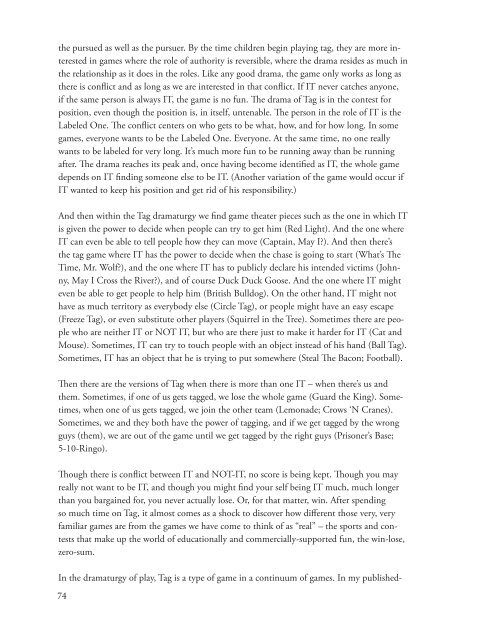A-Playful-Path_DeKoven-web
A-Playful-Path_DeKoven-web
A-Playful-Path_DeKoven-web
You also want an ePaper? Increase the reach of your titles
YUMPU automatically turns print PDFs into web optimized ePapers that Google loves.
the pursued as well as the pursuer. By the time children begin playing tag, they are more interested<br />
in games where the role of authority is reversible, where the drama resides as much in<br />
the relationship as it does in the roles. Like any good drama, the game only works as long as<br />
there is conflict and as long as we are interested in that conflict. If IT never catches anyone,<br />
if the same person is always IT, the game is no fun. The drama of Tag is in the contest for<br />
position, even though the position is, in itself, untenable. The person in the role of IT is the<br />
Labeled One. The conflict centers on who gets to be what, how, and for how long. In some<br />
games, everyone wants to be the Labeled One. Everyone. At the same time, no one really<br />
wants to be labeled for very long. It’s much more fun to be running away than be running<br />
after. The drama reaches its peak and, once having become identified as IT, the whole game<br />
depends on IT finding someone else to be IT. (Another variation of the game would occur if<br />
IT wanted to keep his position and get rid of his responsibility.)<br />
And then within the Tag dramaturgy we find game theater pieces such as the one in which IT<br />
is given the power to decide when people can try to get him (Red Light). And the one where<br />
IT can even be able to tell people how they can move (Captain, May I?). And then there’s<br />
the tag game where IT has the power to decide when the chase is going to start (What’s The<br />
Time, Mr. Wolf?), and the one where IT has to publicly declare his intended victims (Johnny,<br />
May I Cross the River?), and of course Duck Duck Goose. And the one where IT might<br />
even be able to get people to help him (British Bulldog). On the other hand, IT might not<br />
have as much territory as everybody else (Circle Tag), or people might have an easy escape<br />
(Freeze Tag), or even substitute other players (Squirrel in the Tree). Sometimes there are people<br />
who are neither IT or NOT IT, but who are there just to make it harder for IT (Cat and<br />
Mouse). Sometimes, IT can try to touch people with an object instead of his hand (Ball Tag).<br />
Sometimes, IT has an object that he is trying to put somewhere (Steal The Bacon; Football).<br />
Then there are the versions of Tag when there is more than one IT – when there’s us and<br />
them. Sometimes, if one of us gets tagged, we lose the whole game (Guard the King). Sometimes,<br />
when one of us gets tagged, we join the other team (Lemonade; Crows ‘N Cranes).<br />
Sometimes, we and they both have the power of tagging, and if we get tagged by the wrong<br />
guys (them), we are out of the game until we get tagged by the right guys (Prisoner’s Base;<br />
5-10-Ringo).<br />
Though there is conflict between IT and NOT-IT, no score is being kept. Though you may<br />
really not want to be IT, and though you might find your self being IT much, much longer<br />
than you bargained for, you never actually lose. Or, for that matter, win. After spending<br />
so much time on Tag, it almost comes as a shock to discover how different those very, very<br />
familiar games are from the games we have come to think of as “real” – the sports and contests<br />
that make up the world of educationally and commercially-supported fun, the win-lose,<br />
zero-sum.<br />
In the dramaturgy of play, Tag is a type of game in a continuum of games. In my published-<br />
74


